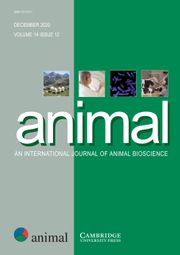Article contents
Effect of farming practices for greenhouse gas mitigation and subsequent alternative land use on environmental impacts of beef cattle production systems
Published online by Cambridge University Press: 29 November 2012
Abstract
This study evaluated effects of farming practice scenarios aiming to reduce greenhouse gas (GHG) emissions and subsequent alternative land use on environmental impacts of a beef cattle production system using the life cycle assessment approach. The baseline scenario includes a standard cow–calf herd with finishing heifers based on grazing, and a standard bull-fattening herd using a diet mainly based on maize silage, corresponding to current farm characteristics and management by beef farmers in France. Alternative scenarios were developed with changes in farming practices. Some scenarios modified grassland management (S1: decreasing mineral N fertiliser on permanent grassland; S2: decreasing grass losses during grazing) or herd management (S3: underfeeding of heifers in winter; S4: fattening female calves instead of being reared at a moderate growth rate; S5: increasing longevity of cows from 7 to 9 years; S6: advancing first calving age from 3 to 2 years). Other scenarios replaced protein sources (S7: partially replacing a protein supplement by lucerne hay for the cow–calf herd; S8: replacing soya bean meal with rapeseed meal for the fattening herd) or increased n-3 fatty acid content using extruded linseed (S9). The combination of compatible scenarios S1, S2, S5, S6 and S8 was also studied (S10). The impacts, such as climate change (CC, not including CO2 emissions/sequestration of land use and land-use change, LULUC), CC/LULUC (including CO2 emissions of LULUC), cumulative energy demand, eutrophication (EP), acidification and land occupation (LO) were expressed per kg of carcass mass and per ha of land occupied. Compared with the baseline, the most promising practice to reduce impacts per kg carcass mass was S10 (all reduced by 13% to 28%), followed by S6 (by 8% to 10%). For other scenarios, impact reduction did not exceed 5%, except for EP (up to 11%) and LO (up to 10%). Effects of changes in farming practices (the scenarios) on environmental impacts varied according to impact category and functional unit. For some scenarios (S2, S4, S6 and S10), permanent grassland area and LO per kg of carcass decreased by 12% to 23% and 9% to 19%, respectively. If the ‘excess’ permanent grassland was converted to fast-growing conifer forest to sequester carbon in tree and soil biomass, CC/LULUC per kg of carcass could be reduced by 20%, 25%, 27% and 48% for scenarios S2, S4, S6 and S10, respectively. These results illustrate the potential of farming practices and forest as an alternative land use to contribute to short- and mid-term GHG mitigation of beef cattle production systems.
Information
- Type
- Farming systems and environment
- Information
- Copyright
- Copyright © The Animal Consortium 2012
References
- 16
- Cited by

